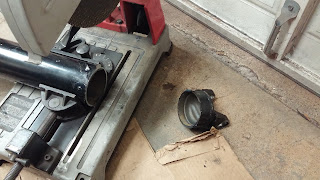Below is the worms eye view of the layout for the parking brake cable change I am making. Left is the focus setup. Right is the mustang setup. The main difference is where the cable sheath goes (shown in green). On the focus it starts from a bracket near the parking brake lever, and it ends at some point near the drum housing.
 |
| worms eye view. Blue is the cable. Green is the cable sheath. Red is the cable bit attached to the handbrake. Left diagram: Focus cable layout. Right diagram: mustang cable layout. |
There were 3 problems with the focus cable:
1) The spring on the cable that retracts the parking brake shoe was too short.
2) The clip that holds the cable into the drum housing was flimsy brittle plastic, and the hole was slightly bigger on the drum which put more stress on this plastic.
3) Since the sheath ends before the drum, I would have had to weld up some large bracket to the control arm to receive it
The image on the right shows the mustang cable. Here the cable goes all the way into the drum housing, so it instantly solves 1,2, and 3. However, some fab was needed to put the mustang pulleys, and a new sheath termination bracket.
First I had to cut off the old focus parking brake bracket. This is exactly what the plasma cutter is for:
When I started laying this out, I found that one mustang cable was frozen into the housing, and I couldn't get it to free up so I had to get another from summit before I could continue. Below is the final routing tacked in.
Here is the rest of the cable routing to the brake drum housing. I zip tied the housing to the control arm at least for now to make sure it stays off the tire.





















































